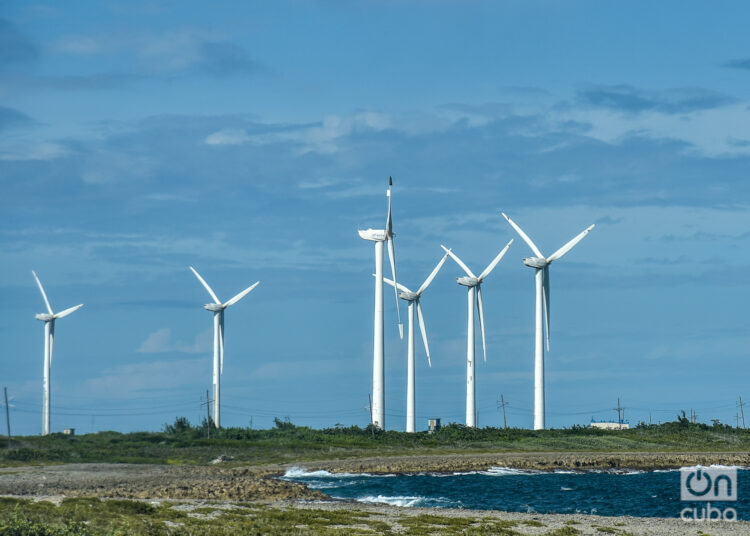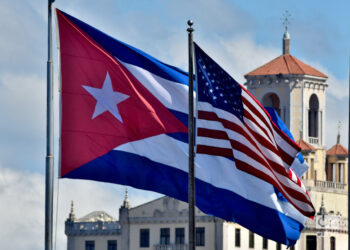Ten years after its approval, the Policy for the Perspective Development of Renewable Sources and the Efficient Use of Energy in Cuba remains little more than a wish list. The history of the Herradura wind farms, in the north of Las Tunas, confirms this.
The first of the complexes started being built at the beginning of 2019, part of a project that included 34 mills each 70 meters high, with the capacity to jointly generate up to 51 megawatts per hour (MWh). By way of comparison, the Gibara wind farms, the first in Cuba, 40 kilometers to the east, in Holguín, had started working in the 2000s, with a design capacity of 9.6 MWh provided by 12 generators, each 50 meters high.
The wind power development plan in Las Tunas contemplated a three-phase process for La Herradura and an additional wind farm in the municipality of Manatí (50 kilometers west of there). Herradura 1 would be followed shortly after by Herradura 2 (with 50 MWh of installed power) and, in the longer term, Herradura 3 (30 MWh). These would have national financing, while the project in Manatí (122 MWh) depended on foreign investment, the specific origin of which has not been specified. Only the power of the first two farms in La Herradura would be enough to almost cover the maximum power demand of the province of Las Tunas, it was said at the time.
The bet turned out to be too ambitious, given Cuba’s economic conditions. Even for countries with long experience in generating wind power, such an installation requires a considerable investment. In Spain, for example, it is estimated that the assembly of a wind farm on land takes between four and eight years and that the process can extend to more than a decade if it involves marine sites.
Shortly after starting work on Herradura 1, Cuba found itself in the middle of the fuel crisis of September 2019, which, despite having cargo transportation as one of the prioritized sectors for supply, ended up affecting it. This sector was essential for the first phase of the project when the giant bases of the wind-driven generators had to be cast.
Then, the pandemic and the subsequent crisis continued to delay the schedule, to the point where President Miguel Díaz-Canel found it when visiting the complex in April 2024: the Ministry of Energy and Mines had decided that, at least for now, Herradura 1 would be limited to putting into operation 22 mills with a combined power of 33 MWh. The gradual incorporation of this equipment will occur in the remainder of 2024 and in 2025, the president was assured, as reported by the newspaper Trabajadores.
During the government inspection, those in charge of the work stated that the Herradura 2 park was “under construction,” but they did not venture a delivery date; nor did they say anything about the completion of Herradura 1 or the probable future of Herradura 3.
A unique event has occurred in the Herradura wind farms for this type of project. Before the pandemic disrupted logistics chains worldwide, delays were common in delivering wind-driven generators and other wind farm equipment by suppliers. This circumstance influences all areas of the wind power industry, but in particular, it affects the requirements to obtain bank loans with which new farms are financed.
Most of the payment terms assumed by loan applicants usually run based on the delivery of the wind-driven generators, which is why installing them and starting production becomes the top priority.
In Herradura 1, according to state media, most of the technological plant has been in Cuba for years, but it has been the lack of resources to complete the civil works (roads, bases, networks and electrical substation…) that has delayed the completion of the farm.
Even though five years ago the Cuban economy was in a better situation than today (4.5 million foreign tourists visited the island in 2019, almost double that of 2023, and remittances doubled the current amounts), at that time a contraction in the main sources of foreign currency was already evident, which called into question the country’s ability to complete large projects only with its own capital.
To ensure success, foreign investment and advice were needed. The 2014 edition of the Foreign Investment Opportunities Portfolio ― the first presented since the announcement of the Herradura projects ― included maps listing the country’s planned renewable complexes, including the Herradura 1 and 2, but no specific proposal regarding capital management for the Las Tunas complex. In fact, said Portfolio shows that the interest of the Ministry of Foreign Trade and Foreign Investment was aimed at attracting foreign financiers for two other wind farms, in Banes and Maisí; the Herradura complexes were borne by the Cuban State.
Not even in the most recent edition of this portfolio do the projects — Herradura 3, still unstarted — come out to tender. Although the energy sector is the second with the highest number of proposals at the country level (129), in Las Tunas there is barely one call to attention to potential investors: that of a 17 MWh photovoltaic park worth 60 million dollars.
It seems to be a paradigmatic example of what in December 2021 Minister of Foreign Trade and Foreign Investment Rodrigo Malmierca described as “unintentional and ineffective promotion” when referring to the balance of the implementation of the Law on Foreign Investment in the country.
At least in the beginning, Herradura 1 was financed with a Chinese state loan that included the transfer of technology manufactured in that country. The first announcements about the farm were made in 2013, with the intention that it would be operational by the beginning of 2018, analysts Jorge Piñón and Ricardo Torres recalled in December 2022, in an article for the Cuba Capacity Building project, from the University of Columbia. The work had ended up becoming an example of the “lost opportunities” for the island in its attempt to modernize its energy matrix, the experts considered.
Failure of “green oil”
The bioelectric plant attached to the Ciro Redondo sugar mill, in Ciego de Ávila, was, in the opinion of Piñón and Torres, the other great commitment to renewables undertaken in Cuba during the previous decade.
It is a Chinese technology plant with the capacity to generate up to 62 MWh based on the burning of bagasse and marabú. Its construction and management were awarded to a company named Biopower S.A., with British-Cuban joint capital, which had to share its experiences with Azcuba and the Electricity Conglomerate to replicate the project in another 24 plants, each with between 20 and 60 MWh of power.
The Renewable Sources Development Policy anticipated since 2014, the year of its publication, that at this time the joint generation capacity of bioelectric plants would exceed 570 MWh. And that at the end of the management chart of its investments ― at the end of 2026 ― its contribution would reach 870 MWh. The figure is equivalent to 25% of the maximum electricity demand in the country at present, which according to the daily reports of the Electricity Conglomerate ranges between 3,200 and 3,500 MWh.
It was not a strange idea. In 1970, the sugar industry produced 18% of the power generated in Cuba that year, when 4,888.5 gWh were generated. Of them, 880.5 gWh by the sugar industry. The unique thing is that the electricity from sugar mills is concentrated in the four or five months of the harvest, a period in which the participation of the sugar mills in power generation is much greater, proportionally speaking. Still in 2000, the generation of the mills was equivalent to 6% of the country’s total production (about 150 MWh, taking into account the current capacities of the SEN). In essence, sugar mill plants are small thermoelectric plants that use bagasse instead of oil to generate the current that moves the tandems and other equipment involved in the manufacture of sugar.
Even the oldest mills are capable of meeting their energy needs from biomass and contributing to the National Electricity System (SEN), a study by the Cuban Ministry of Science, Technology and Environment concluded in the mid-1990s, which is available on the platform of the UN Food and Agriculture Organization (FAO). “The consumption of power for the factory’s driving equipment is in the order of 15-25 kWh/ton cane,” the authors of the text noted; meanwhile, by burning the same volume of organic matter, between 27 and 47 kilowatts can be obtained, depending on the type of cogeneration technology installed.
As in Herradura 1, in the Ciro Redondo bioelectric plant the state investment policy “failed in what was easy,” as they say in baseball; that is to say, they stopped investing in the sugarcane fields that were to provide the bagasse or in the marabú crops, and instead opted for the difficult undertaking (under Cuban conditions) of building the plant.
In March 2022, exactly two years after being synchronized to the SEN, the bioelectric plant was operating at half capacity, mainly due to the insufficient availability of sugar cane and marabú, Cubadebate reported. The first was more difficult to solve, given the lack of fuel and fertilizers to recover the plantations, but the shortage of the second was — to say the least — surprising.
The lack of marabú for the plant’s ovens was due to the breakage of the harvesters, Granma newspaper’s correspondent said after a visit to the fields. “Of the 11 parks, only four remain active, although there were days when only one was in action. What happened was that the investment money was not enough to purchase parts, new harvesters, or to activate the machinery workshop, which never existed,” he noted.
Two years later, last February, the situation had practically not changed, Díaz-Canel learned when touring the Ciro Redondo plant. “Here we have buried the country’s money,” he lamented.
During the last few years, in both factories ― bioelectric and sugar cane ― investments have taken place without their energy and sugar contributions reaching what was expected, to the point of making the state press abandon its traditional optimism for a pessimistic caution. The Azcuba group, owner of the plants and the entity on which the investment depended, reported at the beginning of June on the upcoming construction of a sugar mill, which will be the first built in Cuba in more than 40 years, at the mercy of foreign capital and with an attached 100 MWh bioelectric plant. This would almost double the loss of the Ciego de Avila sugar mill.
As in the previous investments, and in the ambitious plan on photovoltaic energy that Minister of Energy and Mines Vicente de la O Levy announced in March, the announcements come loaded with details about the benefits that these projects will bring, but they almost omit completely how and who will pay for them.
Among so many comings and goings, the participation of renewables remains approximately where it was ten years ago, when it all began, below 5% of national energy production, according to the ONEI, despite what has been invested.










